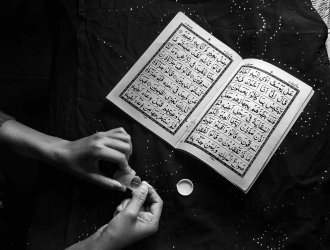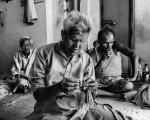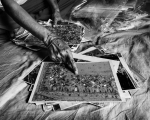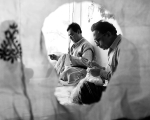Lucknow’s culture has always compelled me to dig into the roots of its rich civilization. The city has been a centre for artistic excellence, and an epitome of the syncretic Ganga-Jamna tehzeeb. As I started exploring the city, I got introduced to its textile culture, particularly the craft of mukaish; a form of embroidery which flourished in Lucknow in the 18th and 19th centuries. The art was patronized by the wealthy Nawabs of Awadh, who made Lucknow their capital city, turning it into one of the great centres of Mughal architecture, arts, culture and etiquette. Mukaish emerged as an innovative embellishment on chikankari—a form of embroidery first developed for the Mughal elite. However, mukaish soon became very popular among the masses, and flourished as high fashion in Lucknowi culture. The artisans who developed this craft came to be known as Badlas.
My work revolves around the life of these Badlas and their families, who are struggling to keep the art alive. I want to tell the story of these artisans through my photographs—their decline, struggle and survival. Lucknow once had more than 3,000 Badlas, but now the number has dwindled to just a handful, all aged above 65, probably the last practitioners of the craft.
Finding these few remaining active Badlas was a difficult task. I serendipitously ran into an old person, who thinking of me as a journalist, provided me the address of one of the last existing Mukaish warehouses in Hussainabad, Old Lucknow. When I reached there, the Badlas initially refused me access to their workspace. Disappointed, I contacted the old man who had given me the address, and returned with him the next day to the Hussainabad warehouse. I was glad that he knew all the craftsmen and introduced me to them. To my surprise, the old man turned out to be a Badla artisan himself, named Sabir Ali, who had now retired due to cataract in his eyes.
Once I started interacting with them, I started understanding the craft and the many challenges faced by the Badlas to ensure its continuity. Mukaish is executed by inserting metallic wires of gold and silver into the fabric, eventually twisting it to create magnificent metallic embroidery on the fabric. Earlier all wires were made of real gold and silver, but due to scarcity and rise of prices, wire makers now use electroplated wires with only a thin coating of gold or silver. One can get it only on demand and they are very highly priced. Due its declining practice, in India there is only one factory which makes the wire used in mukaish, located in Churiwalan in Old Delhi. From Delhi, this wire is exported to Lucknow at a shop called 'Jafar Tui' in Chowk, which is the only place in Lucknow where this wire is sold. This is only one example of how changes in demand, technology, costs and raw materials, have profoundly affected the practice and production of the craft.
These artisans are a treasure of Indian art and craft. Badla artisans devote their lives to the art form, but barely make 100 to 120 rupees a day. They work for long hours, 8 to 10 hours each day, in insalubrious conditions. The warehouses they work in are dingy and suffocating, with tiny rooms. Seventy-five–year old Sabir Hussain, who has been working as a Badla for nearly 65 years, complains of exploitation by their masters who control the means of production. Unfortunately, even the government has been apathetic towards the plight of the Badlas, and by the time of the next generation this craft might become history.
















